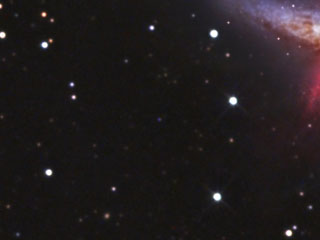|
M82
- Enhanced Hydrogen Comparison
Peculiar
Galaxy in Ursa Major
Uploaded
3/20/07

|
This very peculiar
edge on spiral galaxy is both bright and a challenge to process
because of the very faint an tenuous hydrogen streamers projecting
from the core in a bipolar fashion. The image on the left is
a total of 4h of exposure and represents the standard G2V calibrated
view of this enigmatic object. On the right 5h of additional
hydrogen light exposure data was added to bring up the incredible
sprays of gas emanating from the core.
Field Description:
M82 dominates
the center of this image, spanning a huge 11 arcminutes across,
this 9.3 magnitude spiral is inclined only 7 degrees from our
line of sight. Classed as an IO sp, this peculiar galaxy is famous
for the expanding bipolar outflow of hydrogen emanating perpendicular
to the disk. This galaxy is moderately red, with a B-V index
of .90 it is ruddier than most. This galaxy also has an IRAS
designation as well as an ARP number.
 |
Just
to the lower left in this image from the galaxies core, we find
a 20th magnitude quasar, Hoag 1 which beams with a soft blue
color in the center of this image. We know today that quasars
are active galactic nuclei - black holes, in very distant galaxies.
This field goes down to 22rd magnitude. |
Two very dim
spirals also can be seen in the entire frame shot (top of this
page). Just to the lower left of the bright orange 9th magnitude
star that is blazing to the upper right of M82 is MAC 0954+6944,
a 17th magnitude object barely .5 minutes across. The very obvious
face on spiral to the lower left of the field is MAC 0958+6936
which is a 18th magnitude object with a bright core spanning
.4 minutes in size. Finally, two deep yellow galaxy clusters
are along the right edge. One at the top contains dozens of members,
mostly 19 - 21st magnitude.
|
Instrument: 12.5" f/5 Home made Newtonian
Mount: Astrophysics 1200 QMD
CCD Camera: SBIG 10XME NABG with Enhanced Water Cooling
Guider: SBIG ST4 w/Lumicon Newt Easy Guider
Exposure: Ha+LRGB = 300+120:40:40:40 (RGB Binned 2x2)
AstroDon RGB Combine Ratio: 1: 1.05: 1.11
Location: Payson, Arizona, Elevation: 5150 ft.
Sky: Seeing FWHM = 6 arcsec (Maxim DL - 10min subframe), Transparency 8/10
Outside Temperature: 45 F
CCD Temperature: -30 C
Image Processing Tools:
Maxim DL: Calibration, deblooming (Starizona Debloomer), aligning, stacking
Gralaks Sigma: Stacking
PixInsight: Curves, Deconvolution, noise reduction
Photoshop CS2: Curves, Color Correction, Gradient removal (Grad Xterminator), Cleanup
HOME GALAXIES EMISSION NEBS REFLECTION NEBS COMETS
GLOBULARS OPEN CLUST PLANETARIES LINKS
|
w |